SMPTE SD/HD/3G-SDI 3.0
Product Guide
PG071 October 2, 2013
�
Table of Contents
IP Facts
Chapter 1: Overview
SMPTE Interface Standards . . . . . . . . . . . . . . . . . . . . . . . . . . . . . . . . . . . . . . . . . . . . . . . . . . . . . . . . . . 6
Feature Summary. . . . . . . . . . . . . . . . . . . . . . . . . . . . . . . . . . . . . . . . . . . . . . . . . . . . . . . . . . . . . . . . . . 8
Applications . . . . . . . . . . . . . . . . . . . . . . . . . . . . . . . . . . . . . . . . . . . . . . . . . . . . . . . . . . . . . . . . . . . . . . 9
Licensing . . . . . . . . . . . . . . . . . . . . . . . . . . . . . . . . . . . . . . . . . . . . . . . . . . . . . . . . . . . . . . . . . . . . . . . . . 9
Chapter 2: Product Specification
Standards . . . . . . . . . . . . . . . . . . . . . . . . . . . . . . . . . . . . . . . . . . . . . . . . . . . . . . . . . . . . . . . . . . . . . . . 10
Performance. . . . . . . . . . . . . . . . . . . . . . . . . . . . . . . . . . . . . . . . . . . . . . . . . . . . . . . . . . . . . . . . . . . . . 12
Resource Utilization. . . . . . . . . . . . . . . . . . . . . . . . . . . . . . . . . . . . . . . . . . . . . . . . . . . . . . . . . . . . . . . 12
Core Architecture. . . . . . . . . . . . . . . . . . . . . . . . . . . . . . . . . . . . . . . . . . . . . . . . . . . . . . . . . . . . . . . . . 13
Chapter 3: Designing with the Core
General Design Guidelines . . . . . . . . . . . . . . . . . . . . . . . . . . . . . . . . . . . . . . . . . . . . . . . . . . . . . . . . . 25
Resets . . . . . . . . . . . . . . . . . . . . . . . . . . . . . . . . . . . . . . . . . . . . . . . . . . . . . . . . . . . . . . . . . . . . . . . . . . 44
Chapter 4: Customizing and Generating the Core
Vivado Integrated Design Environment . . . . . . . . . . . . . . . . . . . . . . . . . . . . . . . . . . . . . . . . . . . . . . . 45
Interface . . . . . . . . . . . . . . . . . . . . . . . . . . . . . . . . . . . . . . . . . . . . . . . . . . . . . . . . . . . . . . . . . . . . . . . . 45
Output Generation. . . . . . . . . . . . . . . . . . . . . . . . . . . . . . . . . . . . . . . . . . . . . . . . . . . . . . . . . . . . . . . . 46
Chapter 5: Constraining the Core
Required Constraints . . . . . . . . . . . . . . . . . . . . . . . . . . . . . . . . . . . . . . . . . . . . . . . . . . . . . . . . . . . . . . 47
Clock Frequencies . . . . . . . . . . . . . . . . . . . . . . . . . . . . . . . . . . . . . . . . . . . . . . . . . . . . . . . . . . . . . . . . 47
SMPTE SD/HD/3G-SDI 3.0
PG071 October 2, 2013
www.xilinx.com
2
Send Feedback�
Chapter 6: Simulation
Chapter 7: Synthesis and Implementation
Chapter 8: Detailed Example Design
Chapter 9: Test Bench
Demonstration Test Bench . . . . . . . . . . . . . . . . . . . . . . . . . . . . . . . . . . . . . . . . . . . . . . . . . . . . . . . . . 51
Appendix A: Verification, Compliance, and Interoperability
Hardware Testing. . . . . . . . . . . . . . . . . . . . . . . . . . . . . . . . . . . . . . . . . . . . . . . . . . . . . . . . . . . . . . . . . 52
Appendix B: Migrating and Upgrading
Migrating to the Vivado Design Suite. . . . . . . . . . . . . . . . . . . . . . . . . . . . . . . . . . . . . . . . . . . . . . . . . 53
Upgrading in Vivado Design Suite. . . . . . . . . . . . . . . . . . . . . . . . . . . . . . . . . . . . . . . . . . . . . . . . . . . . 53
Appendix C: Debugging
Finding Help on Xilinx.com . . . . . . . . . . . . . . . . . . . . . . . . . . . . . . . . . . . . . . . . . . . . . . . . . . . . . . . . . 55
Debug Tools . . . . . . . . . . . . . . . . . . . . . . . . . . . . . . . . . . . . . . . . . . . . . . . . . . . . . . . . . . . . . . . . . . . . . 56
Simulation Debug. . . . . . . . . . . . . . . . . . . . . . . . . . . . . . . . . . . . . . . . . . . . . . . . . . . . . . . . . . . . . . . . . 58
Hardware Debug . . . . . . . . . . . . . . . . . . . . . . . . . . . . . . . . . . . . . . . . . . . . . . . . . . . . . . . . . . . . . . . . . 59
Appendix D: Additional Resources
Xilinx Resources . . . . . . . . . . . . . . . . . . . . . . . . . . . . . . . . . . . . . . . . . . . . . . . . . . . . . . . . . . . . . . . . . . 62
References . . . . . . . . . . . . . . . . . . . . . . . . . . . . . . . . . . . . . . . . . . . . . . . . . . . . . . . . . . . . . . . . . . . . . . 62
Revision History . . . . . . . . . . . . . . . . . . . . . . . . . . . . . . . . . . . . . . . . . . . . . . . . . . . . . . . . . . . . . . . . . . 63
Notice of Disclaimer. . . . . . . . . . . . . . . . . . . . . . . . . . . . . . . . . . . . . . . . . . . . . . . . . . . . . . . . . . . . . . . 63
SMPTE SD/HD/3G-SDI 3.0
PG071 October 2, 2013
www.xilinx.com
3
Send Feedback�
IP Facts
Supported
Device Family(1)
Resources
Documentation
Design Files
Example Design
Test Bench
Constraints File
Simulation
Models
Supported
Software Drivers
Design Entry
Tools
Simulation
Synthesis Tools
LogiCORE IP Facts Table
Core Specifics
Zynq®-7000, Artix®-7, Virtex®-7,
Kintex ®-7
Provided with Core
See Table 2-2.
Product Guide
Verilog source code
Provided Separately (2)
See XAPP592 [Ref 8], XAPP892 [Ref 9],
XAPP1092 [Ref 17], and XAPP1097 [Ref 16]
Verilog
XDC
Verilog Structural
Not Applicable
Tested Design Flows
Vivado® Design Suite
For supported simulators, see the Xilinx Design
Tools: Release Notes Guide.
Vivado Synthesis
Support
Provided by Xilinx, Inc.
1. For a complete listing of supported devices, see the Vivado IP
Catalog.
2. Example designs are provided in FPGA device-specific
application notes
3. For the supported versions of the tools, see the Xilinx Design
Tools: Release Notes Guide.
Introduction
The serial digital interface (SDI) family of
standards from the Society of Motion Picture
and Television Engineers (SMPTE) is widely used
in professional broadcast video equipment. The
Xilinx LogiCORE™ IP SMPTE SD/HD/3G-SDI
core interfaces are used by broadcast studios
and video production centers to carry
uncompressed digital video along with
embedded ancillary data such as multiple audio
channels. The SMPTE SD/HD/3G-SDI core
implements interfaces for the SDI family of
standards.
Features
•
Standards compliance:
•
°
°
°
°
°
SMPTE ST 259 (SD-SDI)
SMPTE ST 292 (HD-SDI)
SMPTE ST 372 (Dual Link HD-SDI)
SMPTE ST 424 and ST 425-1 (3G-SDI)
including levels A, B-DL, and B-DS
SMPTE ST 352 (Payload ID)
SMPTE RP 165 (SD-SDI EDH)
°
Triple-Rate SDI receiver features:
°
A single reference clock frequency
supports reception of five different bit
rates:
-
-
-
-
-
270 Mb/s SD-SDI
1.485 Gb/s HD-SDI
1.485/1.001 Gb/s HD-SDI
2.97 Gb/s 3G-SDI
2.97/1.001 Gb/s 3G-SDI
SMPTE SD/HD/3G-SDI 3.0
PG071 October 2, 2013
www.xilinx.com
4
Product Specification
Send Feedback�
°
Automatically detects incoming SDI standard and bit rate
Automatically detects incoming video transport format
°
° Detects and captures ST 352 packets
Checks for CRC errors for HD-SDI and 3G-SDI
°
° Optionally checks for EDH errors for SD-SDI
Triple-Rate SDI transmitter features:
° Only two reference clock frequencies are required to transmit five different bit rates:
•
-
-
-
-
-
270 Mb/s SD-SDI
1.485 Gb/s HD-SDI
1.485/1.001 Gb/s HD-SDI
2.97 Gb/s 3G-SDI
2.97/1.001 Gb/s 3G-SDI
° Generates and inserts CRC and line numbers for HD-SDI and 3G-SDI
° Generates and inserts EDH packets for SD-SDI
° Generates and inserts ST 352 packets for all SDI standards
SMPTE SD/HD/3G-SDI 3.0
PG071 October 2, 2013
www.xilinx.com
5
Product Specification
Send Feedback�
Chapter 1
Overview
SMPTE Interface Standards
The SMPTE SD/HD/3G-SDI core implements three main SMPTE interface standards:
SD-SDI (SMPTE ST 259): SDTV Digital Signal/Data - Serial Digital Interface
•
• HD-SDI (SMPTE ST 292-1): 1.5 Gb/s Signal/Data Serial Interface
•
3G-SDI (SMPTE ST 424): 3 Gb/s Signal/Data Serial Interface
In addition, two SMPTE SDI receivers or transmitters can be combined to implement SMPTE
ST 372 Dual Link HD-SDI interfaces.
SD-SDI
The SMPTE SD/HD/3G-SDI core is designed to support the 270 Mb/s bit rate (level C) of the
SD-SDI standard.
The SMPTE SD/HD/3G-SDI core fully supports the SMPTE RP 165 Error Detection and
Handling (EDH) standard for the receive and transmit sections.
HD-SDI
Although this standard is called a 1.5 Gb/s interface, the bit rates supported by HD-SDI are
actually 1.485 Gb/s and 1.485/1.001 Gb/s. The SMPTE SD/HD/3G-SDI core fully supports
both of these bit rates. The SMPTE SD/HD/3G-SDI core also fully supports generation
(TX-side) and checking (RX-side) of CRC values for each video line and the insertion
(TX-side) and capture (RX-side) of line number values for each line.
3G-SDI
This standard is called a 3 Gb/s interface, but the actual bit rates are 2.97 Gb/s and 2.97/
1.001 Gb/s. The SMPTE SD/HD/3G-SDI core fully supports both of these bit rates. 3G-SDI
supports several different mapping levels, described in the SMPTE ST 425-1 standard. These
levels are called A, B-DL, and B-DS. The SMPTE SD/HD/3G-SDI core supports all three of
SMPTE SD/HD/3G-SDI 3.0
PG071 October 2, 2013
www.xilinx.com
6
Send Feedback�
SMPTE Interface Standards
these levels. As with the HD-SDI standard, the SMPTE SD/HD/3G-SDI core supports CRC
generation and checking and line number insertion and capture for 3G-SDI.
Payload ID
The SMPTE SD/HD/3G-SDI core implements a SMPTE ST 352 payload ID ancillary data
packet insertion capability for the transmitter that works in all SDI modes (SD-SDI, HD-SDI,
3G-SDI, and dual link HD-SDI). The receive side also detects and captures the four data
bytes of ST 352 payload ID packets.
Ancillary Data Support
The SMPTE SD/HD/3G-SDI core allows the application to implement ancillary data packet
insertion prior to transmission. While the core doesn't provide ancillary data packet
insertion capability, except for ST 352 payload ID packets, it has the necessary data paths to
allow ancillary data packet insertion to be implemented by the application. On the receive
side, all embedded ancillary data is preserved by the SMPTE SD/HD/3G-SDI core's receiver
section and is present in the SDI data streams output from the core. Applications can
process the received SDI data streams to receive and/or modify the ancillary data as
needed.
Complete SMPTE SDI Interface Solution
A complete SMPTE SDI interface is comprised of:
• A multi-rate SDI-compliant transceiver
•
The SMPTE SD/HD/3G-SDI core
• Control logic for the transceiver
•
•
Industry standard SDI cable driver (for TX) and SDI cable equalizer (for RX)
Transceiver reference clock source(s)
Figure 1-1 shows a high-level block diagram of an SDI receive/transmit interface using the
SMPTE SD/HD/3G-SDI core. In this figure, a transceiver internal to the Xilinx FPGA is used
with the SMPTE SD/HD/3G-SDI core.
The SMPTE SD/HD/3G-SDI core implements one SDI receiver and one SDI transmitter. If
only a receiver or only a transmitter is needed by the application, the input ports for the
unused half of the core can be tied to ground and the output ports left unconnected. The
synthesis tool will optimize the unused portion of the core out of the application.
When both the receiver and transmitter sections of the SMPTE SD/HD/3G-SDI core are
used, the receiver and transmitter are completely independent. They can be operating in
different SDI modes and bit rates (receiving 3G-SDI at 2.97/1.001 Gb/s while transmitting
SD-SDI at 270 Mb/s or HD-SDI at either bit rate, for example).
SMPTE SD/HD/3G-SDI 3.0
PG071 October 2, 2013
www.xilinx.com
7
Send Feedback�
The SMPTE SD/HD/3G-SDI core always supports all three SDI modes (SD-SDI, HD-SDI, and
3G-SDI). If only a subset of these modes is required by an application, the full SMPTE SD/
HD/3G-SDI core is still used.
X-Ref Target - Figure 1-1
Feature Summary
Figure 1-1: Overview of a Complete SMPTE SDI Interface
1. SDI cable equalizer and cable driver are external to the FPGA.
2. The optional ANC packet insertion function is not included with the SMPTE SD/HD/3G-SDI core.
Feature Summary
The Xilinx SMPTE SD/HD/3G-SDI IP core implements the data path for SDI receivers and
transmitters. A complete SDI interface implementation consists of the SMPTE SD/HD/
3G-SDI core, a transceiver (internal to the FPGA or external), and control logic associated
with the transceiver. The SMPTE SD/HD/3G-SDI core supports SD-SDI, HD-SDI, and 3G-SDI
(level A, level B-DL, and level B-DS) and dual link HD-SDI standards. The SMPTE SD/HD/
SMPTE SD/HD/3G-SDI 3.0
PG071 October 2, 2013
www.xilinx.com
8
Send Feedback�
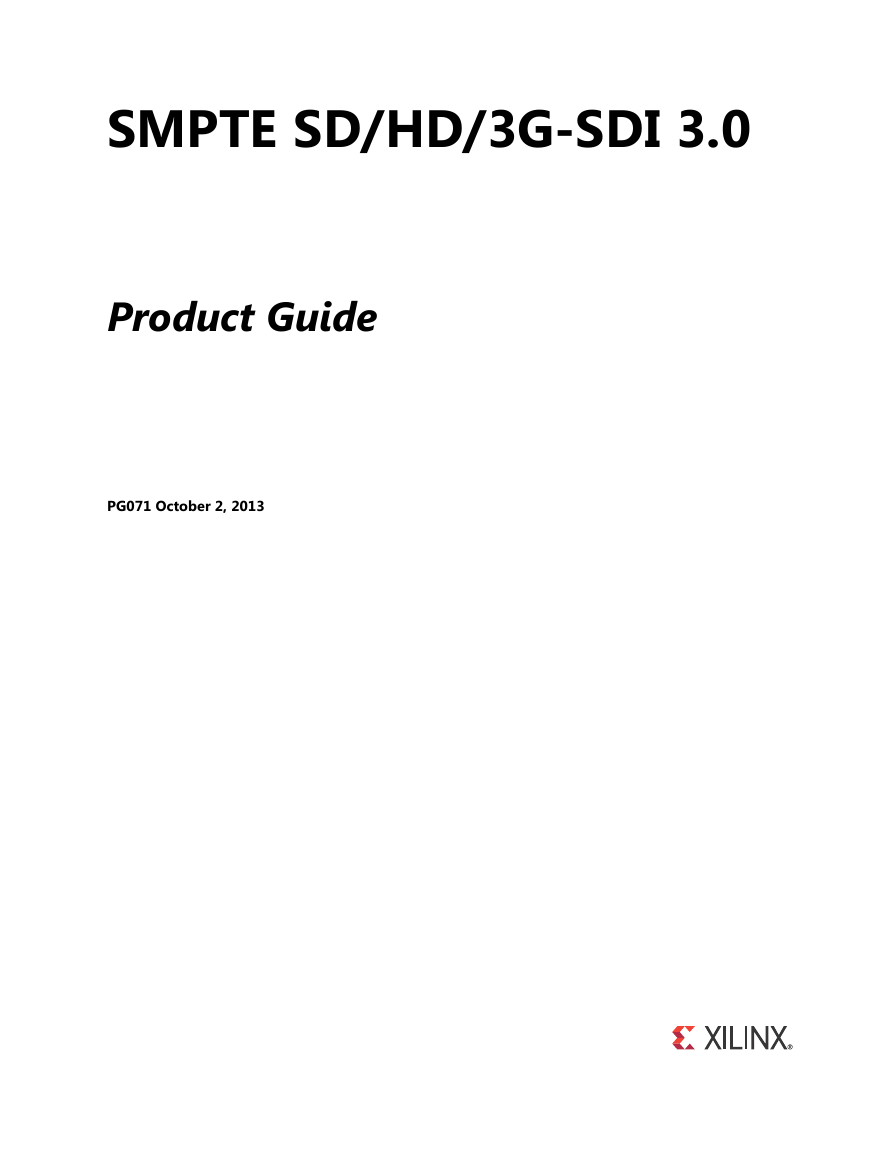

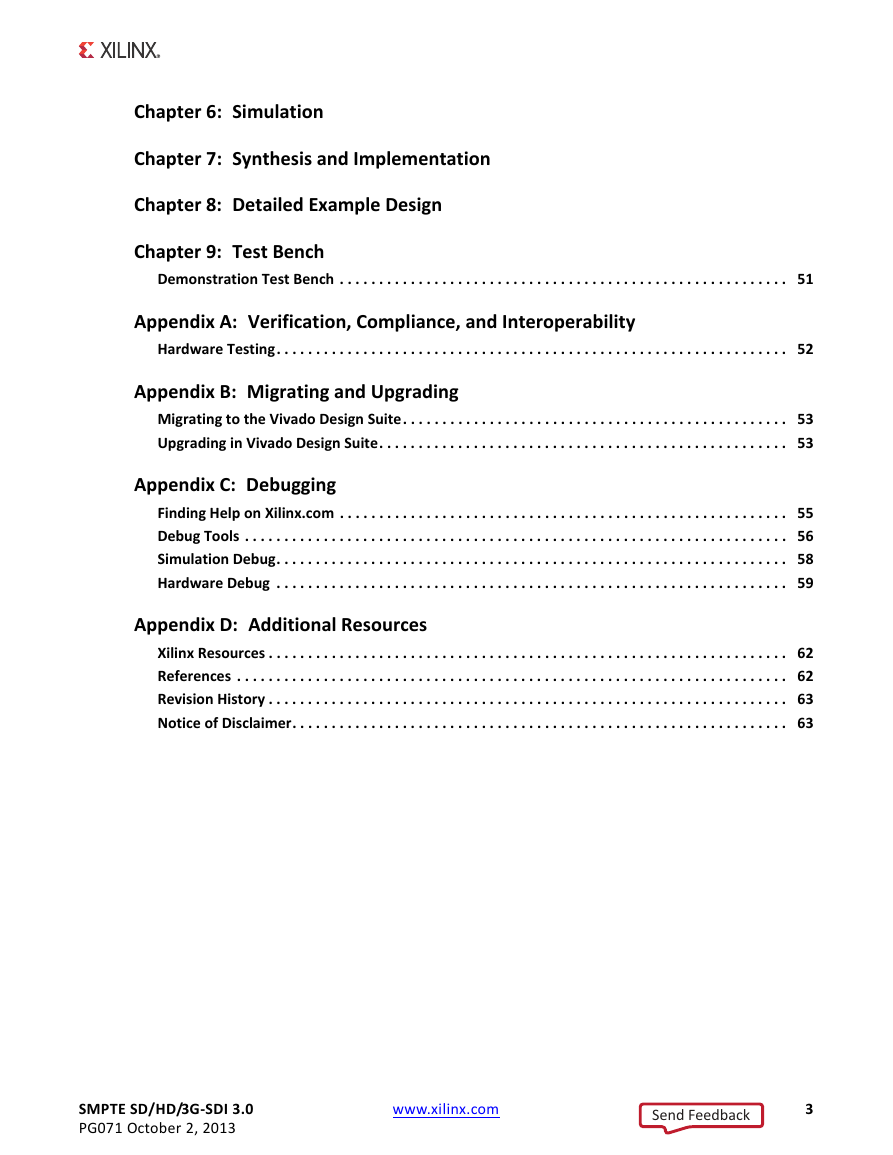
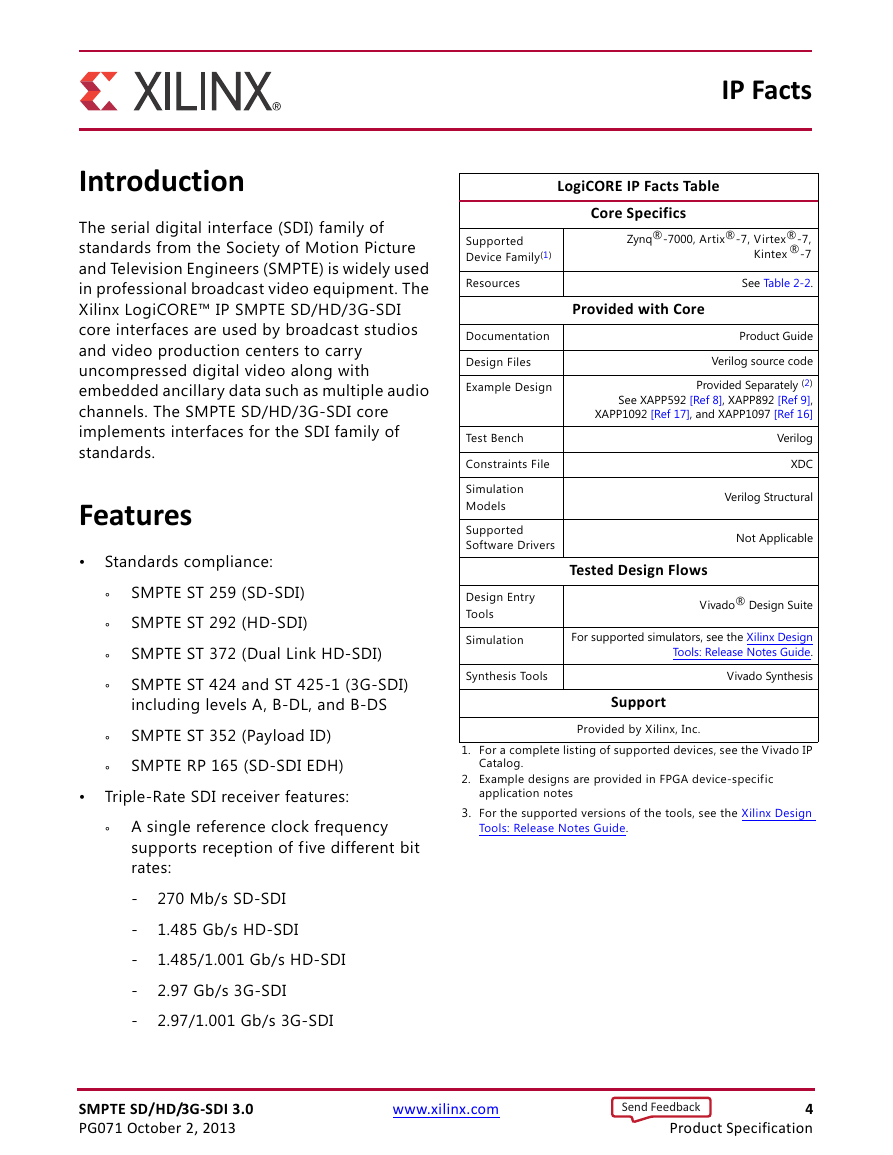
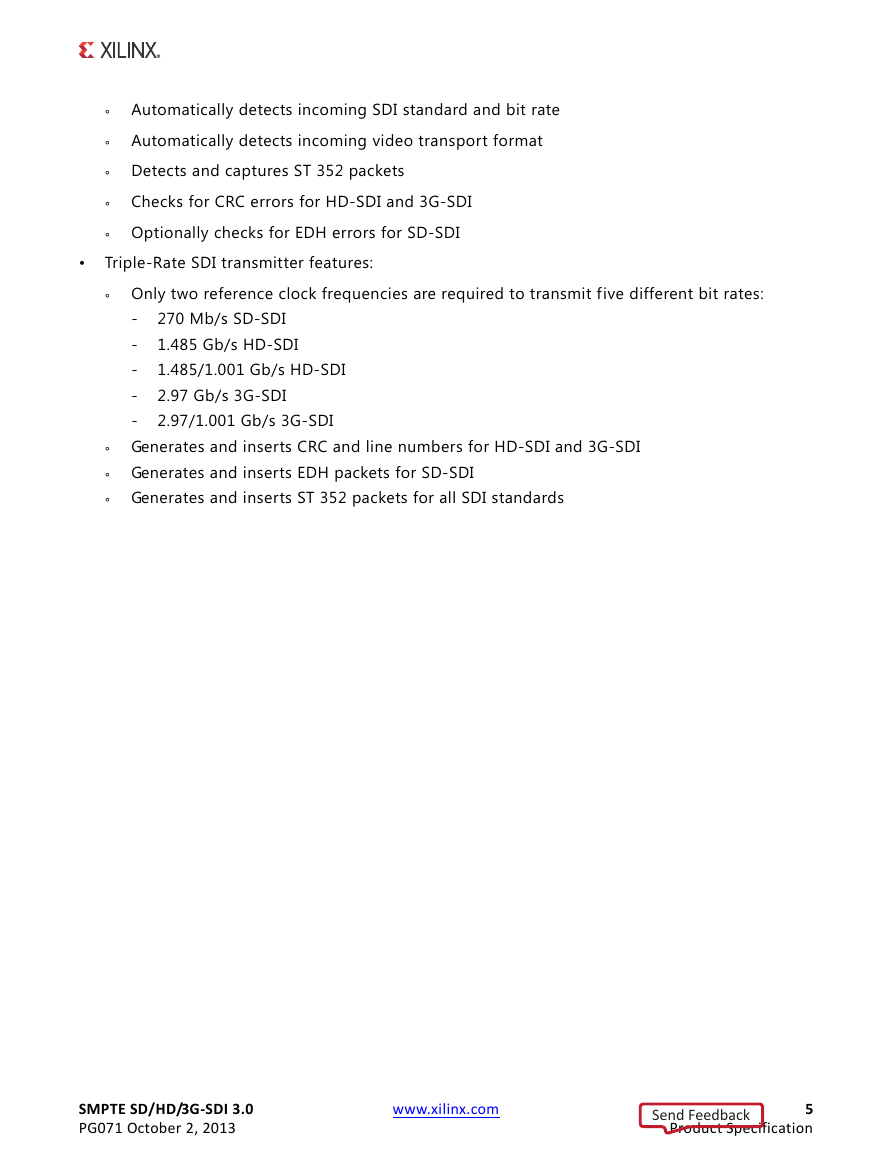
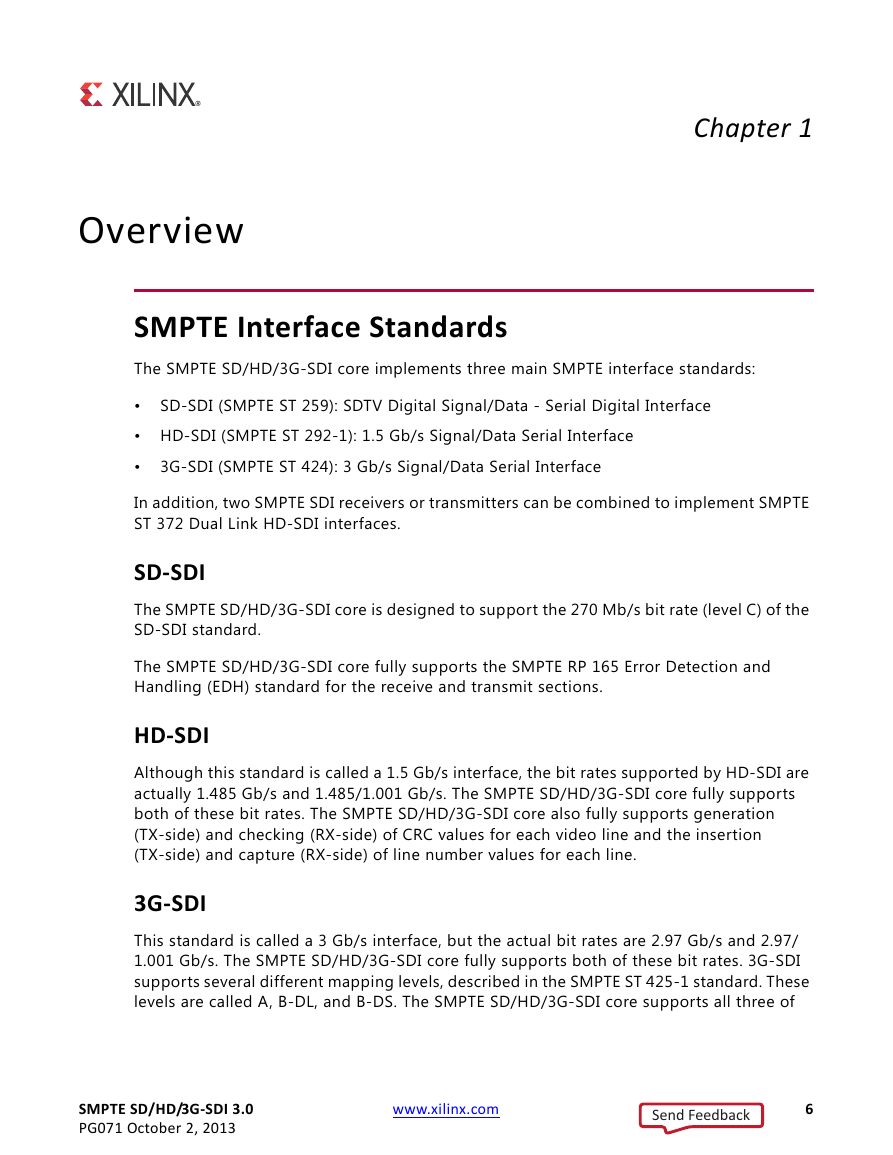
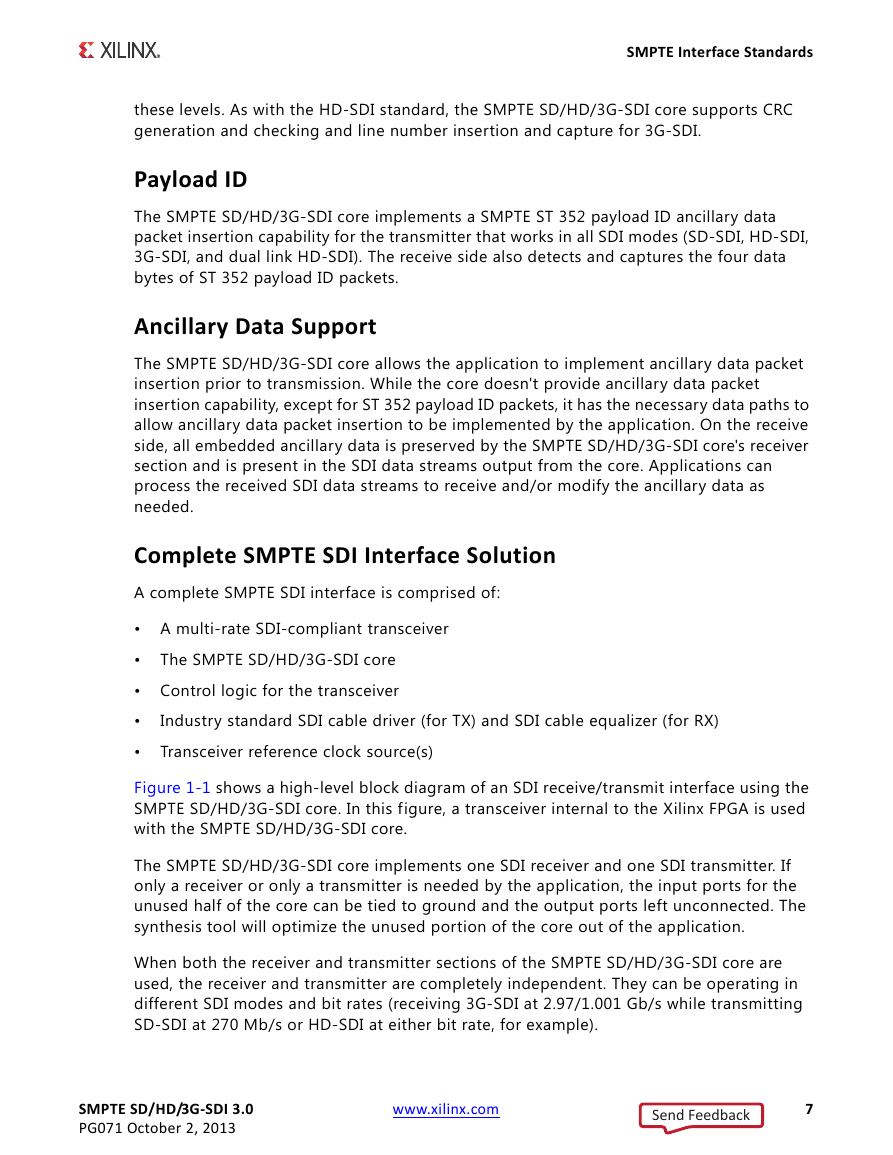
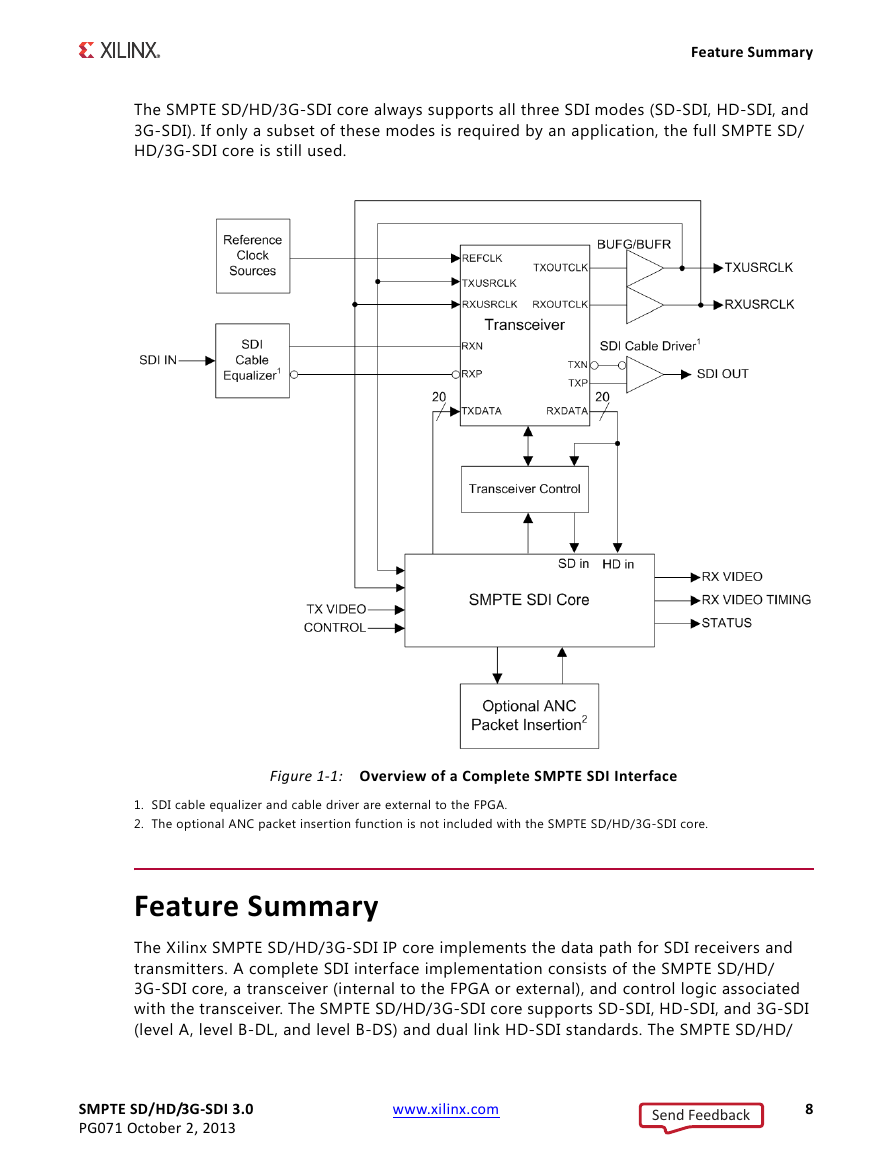








 2023年江西萍乡中考道德与法治真题及答案.doc
2023年江西萍乡中考道德与法治真题及答案.doc 2012年重庆南川中考生物真题及答案.doc
2012年重庆南川中考生物真题及答案.doc 2013年江西师范大学地理学综合及文艺理论基础考研真题.doc
2013年江西师范大学地理学综合及文艺理论基础考研真题.doc 2020年四川甘孜小升初语文真题及答案I卷.doc
2020年四川甘孜小升初语文真题及答案I卷.doc 2020年注册岩土工程师专业基础考试真题及答案.doc
2020年注册岩土工程师专业基础考试真题及答案.doc 2023-2024学年福建省厦门市九年级上学期数学月考试题及答案.doc
2023-2024学年福建省厦门市九年级上学期数学月考试题及答案.doc 2021-2022学年辽宁省沈阳市大东区九年级上学期语文期末试题及答案.doc
2021-2022学年辽宁省沈阳市大东区九年级上学期语文期末试题及答案.doc 2022-2023学年北京东城区初三第一学期物理期末试卷及答案.doc
2022-2023学年北京东城区初三第一学期物理期末试卷及答案.doc 2018上半年江西教师资格初中地理学科知识与教学能力真题及答案.doc
2018上半年江西教师资格初中地理学科知识与教学能力真题及答案.doc 2012年河北国家公务员申论考试真题及答案-省级.doc
2012年河北国家公务员申论考试真题及答案-省级.doc 2020-2021学年江苏省扬州市江都区邵樊片九年级上学期数学第一次质量检测试题及答案.doc
2020-2021学年江苏省扬州市江都区邵樊片九年级上学期数学第一次质量检测试题及答案.doc 2022下半年黑龙江教师资格证中学综合素质真题及答案.doc
2022下半年黑龙江教师资格证中学综合素质真题及答案.doc